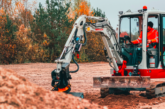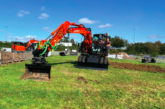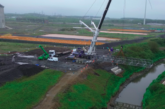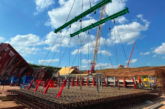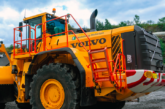The UK construction equipment rental industry is extremely competitive and relatively fragmented. It ranges from national equipment rental companies to local independents all operating within the same market place. Companies vary widely in terms of geographical areas in which they operate, financial resources at hand, brand recognition and equipment offered.
The construction equipment rental market is estimated to be worth approximately close to £5,000m for its hire market prices during 2018. It also experienced good growth between 2014 and 2017, benefiting from a positive performance in most end-use sectors ranging from construction and civil engineering contractors, local authorities, industrial, agricultural as well as homeowners & DIYers. Looking towards the medium term and the prospects for the construction equipment rental market, AMA Research postulate to observe them remain moderately optimistic, with the market forecast to grow by around 11% to 2023.
Earth moving equipment being the likes of excavators, dump trucks and loading shovels, represent the largest equipment sector, accounting for around 22% of all hire value. Other key sectors include lifting and access equipment, such as cranes and forklifts, whilst also including the powered access market as well as scaffolding and ladders.
Many leading hire operators are also able to sell a range of plant and machinery to customers in the UK, with certain hire companies appointed as ‘sole distributors’ for a particular product or range of products. Some hire companies are more reliant on construction whereas other companies have developed into more diverse markets, such as manufacturing, recycling and events. The top 10 companies within the construction equipment rental market account for around 40%.
The need for greater numbers of new dwellings is now a significant focus of Government policy, with a target of building 300,000 new homes a year by 2020. Housebuilding is forecast to continue growing, but numbers are not expected to reach this target level.
The type of dwelling mix impacts on the hire sectors used for construction. Flats benefit hire sectors such as some primary construction equipment required for the construction of multi-story apartments; whilst single storey housing usually creates more demand for tool hire. It is likely that there may be a swing back towards building more flats as urban development schemes in high density population areas gain momentum.
Many companies choose to hire plant and tools rather than purchase the equipment, generally to avoid risk – in particular capital risk, operating risk and legislative / compliance risk. Other benefits may include a tax relief, a call-out service included within the hire, no maintenance costs, flexibility, the ability to trial new products, etc. There are also different types of hire including short-term, long-term and flexi-term (e.g. total set period cost that may match the long-term hire cost but with the option to decide annually if the equipment is to be kept or returned).
The level of hire demand will be dependent on individual end-use sector performance. With the current climate expected to remain challenging, while sectors such as retail and health forecast show a fall in output, moderate levels of growth in construction output is expected to stimulate overall hire demand and growth to 2023.
The information was taken from the Construction Equipment Rental Market Report by AMA Research, which is available to purchase now at www.amaresearch.co.uk or by calling 01242 235724.



